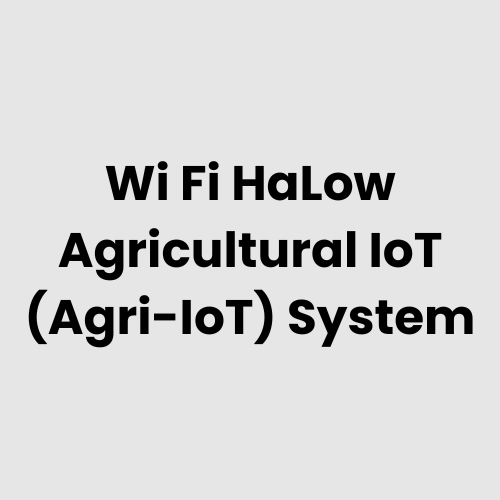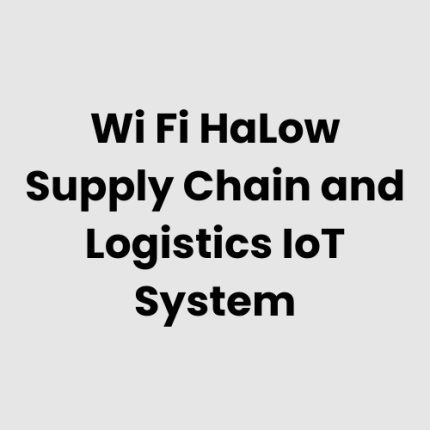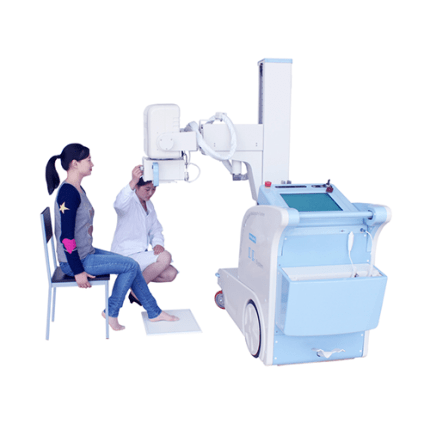Description
Technical Architecture of Wi-Fi HaLow Enabled Agricultural IoT (Agri-IoT) System
The Wi-Fi HaLow Enabled Agricultural IoT (Agri-IoT) System offers a robust framework for agricultural applications requiring long-range, low-power connectivity. It utilizes Wi-Fi HaLow technology, designed to handle the diverse needs of agriculture, from environmental monitoring to resource management. The system integrates sensors, data acquisition devices, communication modules, and a central processing unit, creating a highly scalable solution. Through IoT protocols, it ensures real-time data collection and efficient decision-making processes. By leveraging low-power, wide-area connectivity, this system excels in remote and rural environments.
List of Hardware for Wi-Fi HaLow Enabled Agricultural IoT (Agri-IoT) System
- Wi-Fi HaLow Gateways – Bridges between devices and cloud or local servers, ensuring seamless data transfer.
- Sensors – Environmental sensors (temperature, humidity, soil moisture), CO2 sensors, air quality sensors, and light intensity sensors.
- IoT Nodes – Small, low-power devices that collect and transmit sensor data over Wi-Fi HaLow.
- Power Supply Units – Solar-powered or battery-powered units for remote locations.
- Edge Computing Devices – Local processors that handle real-time data analytics and decision-making.
- Cloud or Local Servers – Stores large volumes of data for analysis and reporting.
- Actuators – Devices that respond to sensor data, such as automated irrigation systems or pest control mechanisms.
- Networking Equipment – Routers and switches optimized for low-power connectivity and large-scale deployments.
- Mobile and Web Interfaces – Devices for monitoring and controlling the system remotely.
Physical Placement Considerations of Wi-Fi HaLow Enabled Agricultural IoT (Agri-IoT) System
When deploying the Wi-Fi HaLow Enabled Agricultural IoT System, placement is key for ensuring optimal coverage and system efficiency. Consider the following:
- Sensor Placement – Sensors should be strategically located throughout the agricultural area to cover critical environmental factors, including soil moisture levels and climate conditions.
- Gateway Placement – Wi-Fi HaLow gateways should be placed centrally to ensure adequate signal reach across the entire farm, reducing data transmission latency.
- Edge Devices – Edge computing devices should be positioned in locations with adequate power access and proximity to high-volume data points for real-time decision-making.
- Power Supply – Solar panels or battery banks should be placed where they receive maximum sunlight and can power the system reliably.
- Actuator Location – Actuators, like irrigation and pest control systems, must be deployed near the operational zones they will manage.
Hardware Architecture of Wi-Fi HaLow Enabled Agricultural IoT (Agri-IoT) System
The architecture of the Wi-Fi HaLow Enabled Agricultural IoT System revolves around a distributed setup, where each component plays a vital role:
- Data Acquisition Layer – Comprises sensors and IoT nodes, which gather real-time data on environmental conditions.
- Connectivity Layer – Includes the Wi-Fi HaLow gateways that enable seamless communication between the sensors, IoT nodes, and the central server.
- Processing Layer – Edge computing devices process data locally to minimize latency and offload simple computations from cloud servers.
- Storage Layer – Local servers or cloud servers store vast amounts of agricultural data for analysis and reporting.
- Action Layer – Based on real-time data, actuators like irrigation systems, temperature controls, and automated machinery are deployed for system management.
Deployment Considerations of Wi-Fi HaLow Enabled Agricultural IoT (Agri-IoT) System
Deployment of the Wi-Fi HaLow Enabled Agricultural IoT System requires careful planning to ensure network stability and efficient operation:
- Network Coverage – Ensure that Wi-Fi HaLow’s long-range capabilities are effectively leveraged, with proper gateway placement to cover the entire farm.
- Power Infrastructure – Deploy sustainable power solutions, such as solar-powered units, especially for remote installations where access to the power grid is limited.
- Scalability – Plan for scalability by selecting modular components and allowing future expansion as the agricultural area grows or more sensors are needed.
- Maintenance – Choose durable hardware components designed for outdoor use in harsh environmental conditions to reduce maintenance overhead.
- Security – Implement robust cybersecurity protocols to protect sensitive agricultural data from potential threats.
List of Relevant Industry Standards and Regulations
- IEEE 802.11ah (Wi-Fi HaLow)
- ISO/IEC 27001 (Information Security Management)
- ISO 14001 (Environmental Management)
- IEC 61508 (Functional Safety)
- CE Marking (European Economic Area standards)
- RoHS (Restriction of Hazardous Substances)
- GDPR (General Data Protection Regulation)
- ISO 9001 (Quality Management Systems)
- FCC Part 15 (Radio Frequency Emissions)
- ITU-T Standards for IoT Communication
Local Server Version: Running with a Local Server
GAO Tek offers the option of deploying the Wi-Fi HaLow Enabled Agricultural IoT System with a local server for farms where cloud-based systems may not be feasible. The local server version allows for centralized data storage and processing without reliance on external cloud platforms. The server provides real-time data access, enabling farmers and operators to make immediate decisions on-site. It also supports advanced analytics, such as predictive maintenance and resource optimization, all while ensuring data privacy and reducing latency.
Cloud Integration and Data Management
For farms seeking a scalable solution, cloud integration provides significant advantages. GAO Tek’s Wi-Fi HaLow Enabled Agricultural IoT System seamlessly integrates with cloud platforms, enabling remote monitoring and control. Through cloud services, agricultural data is stored, analyzed, and accessible from any device with internet connectivity. Real-time data processing capabilities allow for predictive analytics and enhanced decision-making. Moreover, cloud-based solutions offer flexibility, high availability, and backup, ensuring your data is always secure and accessible. This integration also supports machine learning algorithms to optimize agricultural processes based on accumulated data.
At GAO Tek, we specialize in delivering cutting-edge IoT solutions, and our Wi-Fi HaLow Enabled Agricultural IoT System is engineered to meet the evolving needs of modern agriculture. We provide full support from system design to deployment, ensuring that our clients, from Fortune 500 companies to research institutions, can harness the power of connected technologies to drive efficiency, sustainability, and growth in agriculture.
GAO Case Studies of Wi-Fi HaLow Enabled Agricultural IoT (Agri-IoT) System
- New York City, New York
A large urban agricultural project integrated the Wi-Fi HaLow Enabled Agricultural IoT System to monitor environmental conditions in community gardens. This system provided real-time data on soil moisture, temperature, and humidity, enabling more efficient irrigation and resource management. The solution helped optimize crop yields and minimized water wastage. The use of smart city technology in agriculture has been recognized by IEEE and other standards organizations for its efficiency. - Los Angeles, California
In a vineyard in Los Angeles, the system was implemented to track climate conditions and soil quality. By using long-range connectivity, it enabled seamless data transmission across large plots of land. The system provided detailed insights for precision farming, improving crop health and maximizing harvest efficiency. This aligns with advancements in precision agriculture highlighted by USDA. - Chicago, Illinois
A greenhouse operation in Chicago employed the Wi-Fi HaLow Agri-IoT System to monitor light levels, temperature, and CO2 levels. By adjusting environmental variables based on sensor data, the system increased plant growth and reduced energy consumption, providing a more sustainable farming solution in the city’s harsh weather conditions. This type of smart agriculture is supported by the National Agriculture Library. - Phoenix, Arizona
The system was deployed in a large-scale desert farming operation to monitor soil salinity and moisture levels. This enabled the automation of irrigation schedules, ensuring water was used efficiently. The ability to operate over long distances in a desert environment made the Wi-Fi HaLow system ideal for this challenging deployment. Technologies like these are critical in arid regions as emphasized by FAO. - Dallas, Texas
In a dairy farm in Dallas, the Agri-IoT system was used for monitoring animal health and farm conditions. It collected data on temperature, humidity, and milk production, enabling farmers to make real-time adjustments to improve both animal well-being and operational efficiency. The integration of IoT in livestock monitoring has been a focus of the American Dairy Association. - Seattle, Washington
A research farm in Seattle utilized the Wi-Fi HaLow system to monitor and control automated greenhouse operations. The integration of temperature, humidity, and irrigation sensors allowed for precise control, boosting plant yields and reducing water waste in this eco-conscious farming initiative. This research follows best practices outlined by AgFunder Network Partners. - San Francisco, California
A smart farming initiative in San Francisco deployed the Wi-Fi HaLow system to monitor urban agriculture projects. By integrating environmental sensors and a local server for data processing, this solution allowed urban farmers to grow crops efficiently while ensuring sustainability in the city’s dense environment. The smart farming model has been heavily influenced by urban farming trends highlighted by Urban Future Lab. - Boston, Massachusetts
In Boston’s agricultural tech sector, the Wi-Fi HaLow Agri-IoT system was applied to monitor temperature, soil moisture, and weather patterns in a series of indoor farming systems. Real-time data provided insights that allowed for optimized resource use and improved crop growth in an urban environment. This is in line with the goals of MIT Media Lab’s Open Agriculture Initiative. - Miami, Florida
A large-scale citrus farm in Miami integrated the Wi-Fi HaLow IoT system to monitor climate conditions and track the health of crops. The system helped detect early signs of disease and pests, allowing the farm to take preventive action and reduce crop loss. Early pest detection is a key focus of research by Clemson University’s Department of Plant and Environmental Sciences. - Minneapolis, Minnesota
A precision farming project in Minneapolis used the Wi-Fi HaLow system to monitor soil moisture, temperature, and crop health across vast fields. The data collected helped farmers adjust irrigation systems to the needs of individual crops, reducing water waste and increasing productivity. Precision agriculture tools are widely endorsed by the International Society of Precision Agriculture. - Washington, D.C.
In a government-supported urban farming project, the Wi-Fi HaLow system was installed to manage environmental conditions and track crop growth. The integration of real-time data helped adjust lighting, temperature, and humidity to provide optimal conditions for crops in the city’s limited space. This approach mirrors trends in urban agriculture promoted by the National Sustainable Agriculture Coalition. - Atlanta, Georgia
An organic farm in Atlanta used the system to monitor plant growth and soil health. With sensor data processed both locally and on the cloud, farmers received actionable insights into fertilizer and irrigation needs, improving crop performance and sustainability. Organic farming solutions have been advocated by organizations like the Organic Farming Research Foundation. - Houston, Texas
A large-scale cotton farm in Houston leveraged the Wi-Fi HaLow Agri-IoT system to monitor soil health, water consumption, and environmental factors. By analyzing this data, the farm optimized crop rotations and irrigation schedules, resulting in improved cotton yield and resource management. This case supports the principles of sustainable cotton farming supported by Cotton Incorporated. - Orlando, Florida
A citrus grove in Orlando employed the Wi-Fi HaLow system to monitor temperature, humidity, and pest activity. The integration of automated pest control systems based on real-time sensor data helped reduce pesticide use, enhancing sustainability and lowering operational costs. Integrated pest management is a key area of research for The Florida Department of Agriculture and Consumer Services. - Salt Lake City, Utah
A hydroponic farm in Salt Lake City used the Wi-Fi HaLow IoT system to monitor nutrient levels, light intensity, and plant growth in a controlled environment. Real-time sensor feedback helped optimize growth conditions for high-efficiency, soil-free farming. Hydroponics and vertical farming solutions have received increasing attention from The Vertical Farming Institute.
Case Studies in Canada
- Toronto, Ontario
In Toronto, a local farm specializing in hydroponics utilized the Wi-Fi HaLow Agri-IoT system to monitor water quality, nutrient levels, and environmental factors. By integrating IoT sensors, the farm was able to optimize nutrient delivery and reduce waste, increasing crop yields while maintaining environmental sustainability. This initiative aligns with advancements in urban farming technologies championed by City of Toronto. - Vancouver, British Columbia
In Vancouver, the Wi-Fi HaLow system was implemented on a coastal farm to monitor soil moisture levels and environmental conditions. The long-range capabilities of the system made it ideal for this large-scale operation, which focused on sustainable agricultural practices. This project is supported by initiatives from the BC Agriculture Council.
Navigation Menu for Wi-Fi HaLow
- Wi-Fi HaLow Gateways/Routers
- Wi-Fi HaLow End Devices
- Wi-Fi Halow – Cloud, Server, PC & Mobile Systems
- Wi-Fi HaLow Accessories
Navigation Menu for IoT
- LORAWAN
- Wi-Fi HaLow
- Z-WAVE
- BLE & RFID
- NB-IOT
- CELLULAR IOT
- GPS IOT
- IOT SENSORS
- EDGE COMPUTING
- IOT SYSTEMS
Our products are in stock and can be shipped anywhere in the continental U.S. or Canada from our local warehouse. For any further information, please fill out this form or email us.
We are looking for partners. For more information on partnering with GAO, please visit Partner with GAO Tek Inc. It lists various ways to partner with GAO, such as OEM Partnerships, Technology Integration, Distribution and Reselling Opportunities, Presenting at the Leading Event TekSummit, Joint R&D Projects, Training and Consulting Services, Industry-Specific Collaborations, Research and Academic Partnerships.



